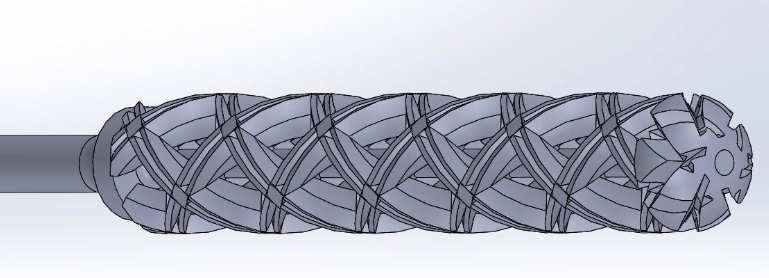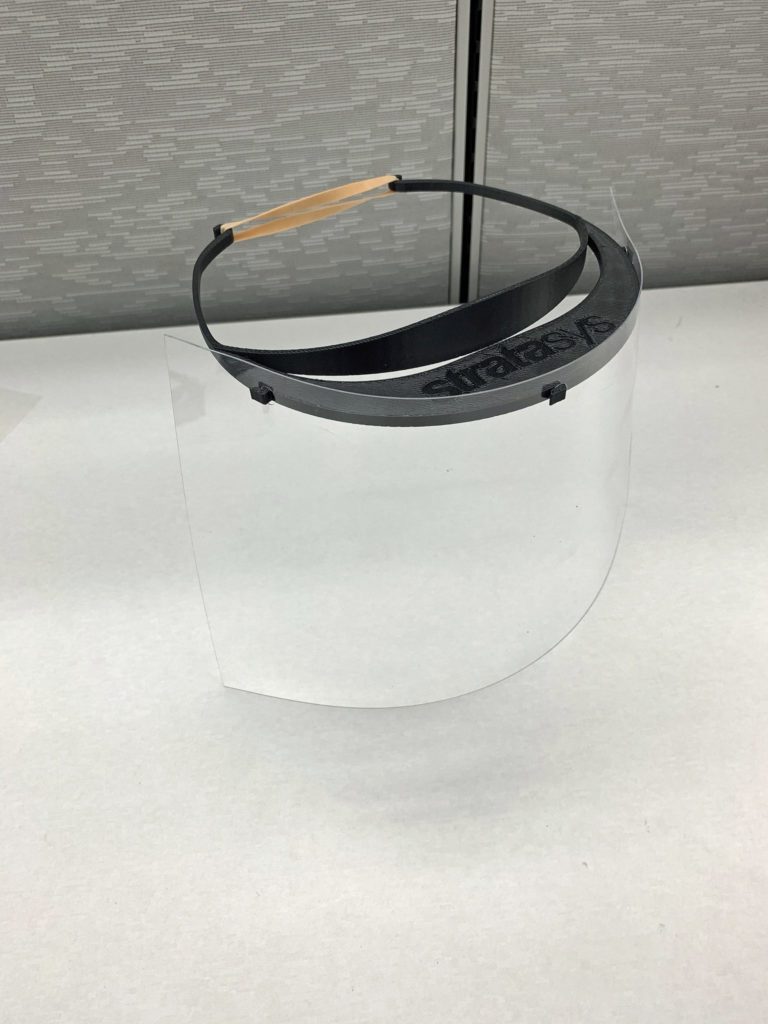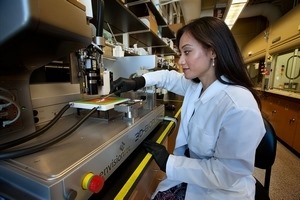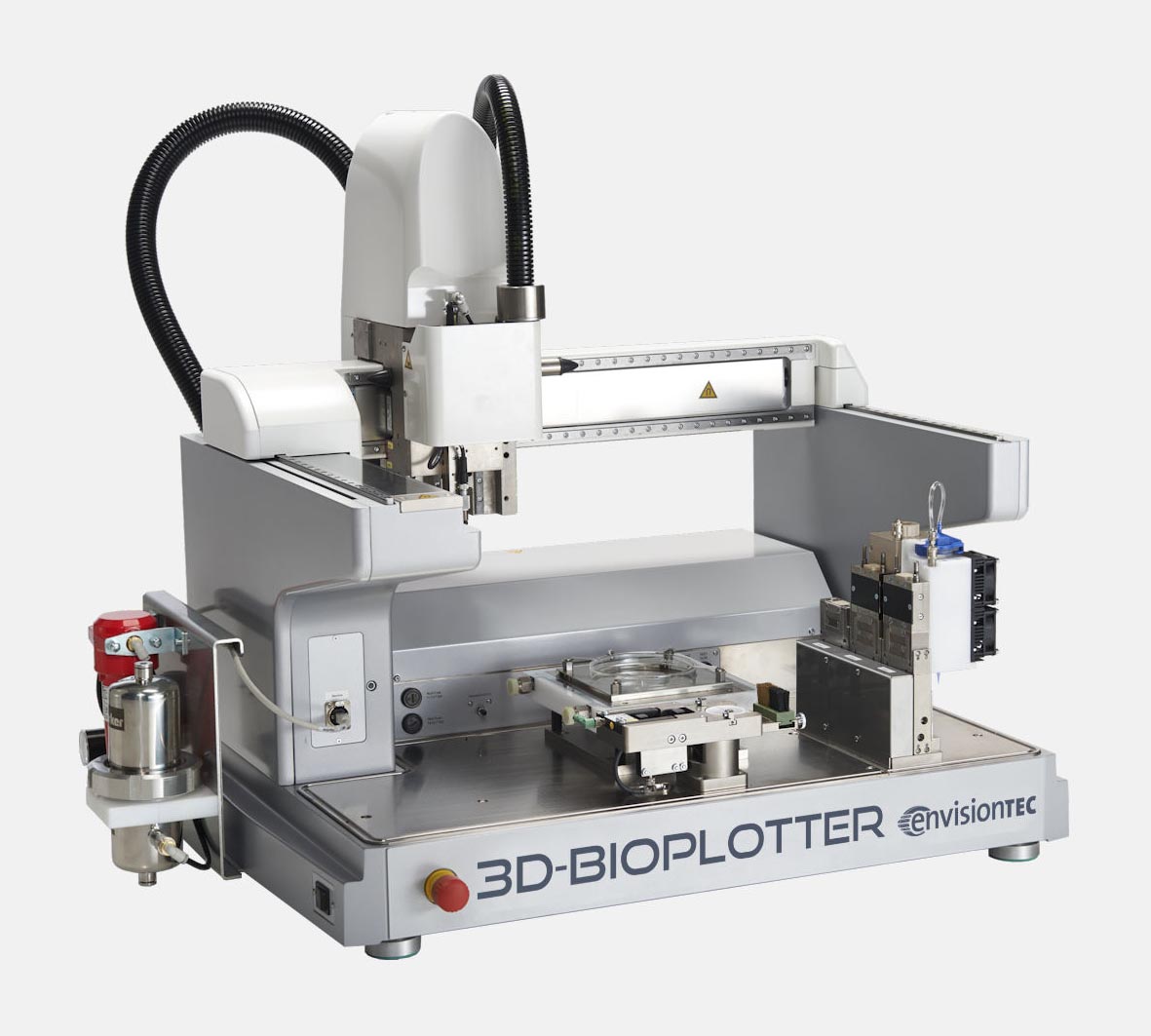3D Printing for COVID-19, Part Nine: Safety Goggles, Swabs and Coalitions
It seems to be the case that 3D printing related relief efforts are beginning to coalesce with government and medical regulatory efforts to, hopefully, ensure that rapid response to the COVID-19 outbreak from the additive manufacturing (AM) community is safe and reliable. The efficacy of the collaboration between these disparate parties is still too early to evaluate easily, however, and we will have a better picture of what this collaboration looks like over time.
Meanwhile, efforts are continuing to provide 3D printed products to fulfill needed medical supplies, sometimes with the help of medical experts and sometimes without. The line between marketing initiative and humanitarianism continues to be blurred.
As reported earlier, Formlabs is already deploying 3D-printed nasal swabs to aid in hospitals in Florida and New York, while Carbon attempts to validate its own nasal swabs. Now, EnvisionTEC is 3D printing nasopharyngeal (NP) swabs for specimen collection for testing, as well as ventilation splitters similar to those previously covered that diverts air from ventilation systems to multiple patients.
To do so, the company is collaborating with the FDA and local Detroit hospitals to print the parts from a Class 1 material. For the NP swabs, EnvisionTEC is working with the Harvard Microbiology Lab and a larger consortium of academic and AM partners. Nilson Laboratories, has designed a flexible swab and printed 400 units in a Class 1 material. These items are still undergoing testing and approval before deployment in the field.
Though a number of entities are 3D printing face shields, Huaxiang Group, Farsoon and LEHVOSS Group are 3D printing safety goggles to protect the highly exposed mucous membrane of the eyes of medical staff. Medical 3D printing experts from Huaxiang Group in China were able to develop, optimize and validate weight-optimized, 3D-printed goggles in a span of 10 days, 3D printing nylon goggle frames and flexible thermoplastic polyurethane sealing rings on Farsoon systems. These parts are then combined with acrylic lenses coated with anti-fogging material.
Huaxiang 3D printed and assembled 1000 pairs of goggles for the Red Cross Society of China as of March 18 and is in the process of producing a second batch for use locally and abroad, including for Italian hospitals and in conjunction with Italian service bureau Prosilas Rapid Prototyping. The design files for the goggles are freely available online.
Other efforts underway include the establishment of a coalition by Stratasys that currently hosts over 150 members, such as Toyota Motor Company, Boeing, the University of Central Florida and more. The company is inviting any party capable of printing a minimum of 100 face shields daily to join by filling out an online form. The group is in the process of building over 11,000 face shields for delivery next week and 16,000 the following week.
Italian arms manufacturer Beretta is continuing to operate through the pandemic due to its status as a critical weapons asset in Italy. To address the crisis, the company is 3D printing replacement Venturi valves on its selective laser sintering machines.
Siemens has opened its Additive Manufacturing Network and its own 3D printing capabilities up to healthcare providers for the rapid production of medical parts. Medical professionals can register for access online.
All of this corporate participation in the fight against the COVID-19 outbreak raises a number of larger questions about whose responsibility it is to manage production under disaster response. We’ve seen how potentially authoritative government control via enforced quarantine can lead to a comparatively quick management of the coronavirus, while laissez faire approaches to management have led to widespread mismanagement and havoc.
Whereas nations have the possibility of mandating their manufacturers to produce vital medical supplies to combat the pandemic—such as with the Defense Production Act in the U.S.—governments with laissez faire economic management approaches are relying on manufacturers to take it upon themselves to do what they believe is best. The result is the ad hoc approach we are seeing with coalitions made up of trade associations, businesses, governments and regulatory bodies.
The case of General Electric is an interesting example. As we’ve previously reported, GE Healthcare is working with Ford to produce simplified versions of GE’s ventilators. However, workers from GE Aerospace in Lynn, Massachusetts are currently protesting that the facility is continuing to manufacture jet turbine parts instead of ventilators. This occurred just as GE announced a massive round of layoffs in which 10 percent of its aviation workforce would be let go in an attempt to save the company $500 to $1 billion. This brings up the point we’ve stressed about whether or not some 3D printing initiatives by businesses in response to the coronavirus outbreak are less about manufacturing needed supplies and more about marketing and appearance.
All of this is to say that, while a nation’s government could simply make demands of its manufacturers to produce the necessary medical equipment and distribute those supplies based on where they are needed, nations with laissez faire bureaucracies are instead relying on ad hoc networks with potentially dangerous manufacturing and distribution procedures. That is why the efforts of regulatory bodies and national and continental 3D printing trade groups, such as those discussed in our last article, may be essential to combat the outbreak. They are essentially (hopefully) bringing order and safety to an otherwise impromptu disaster response.
As the coronavirus outbreak continues to wear on, it is hoped that these diverse efforts will continue to coalesce in non-competitive ways with government and medical bodies better coordinating these disparate groups and ensuring proper regulations are followed. In the meantime, as the novelty of 3D printing for use in a public health emergency wears off, it is also hoped that the marketing takes a backseat to genuinely useful production of needed medical supplies.
The post 3D Printing for COVID-19, Part Nine: Safety Goggles, Swabs and Coalitions appeared first on 3DPrint.com | The Voice of 3D Printing / Additive Manufacturing.
EnvisionTEC-exocad Partnership Signals Industry Integration
For Lab Day 2020, a number of 3D printing companies are rolling out their dental 3D printing product lines. This year, there’s the sense that there is a change taking place within the dental additive manufacturing (AM) space as systems manufacturers move beyond simply presenting their latest wares and, instead, present integrated product suites that tackle entire dental workflows. This reflects a larger trend within the AM space in which the industry is working to create integrated solutions for each vertical.

Dental materials from EnvisionTEC are pre-loaded in exocad’s exoprint module. Image courtesy of EnvisionTEC.
The latest Lab Day announcement comes from EnvisionTEC, who has partnered with dental CAD/CAM software developer exocad to integrate their products. For the past year, EnvisionTEC and exocad collaborated to develop a “seamless workflow” between exocad’s DentalCAD software and EnvisionTEC’s Envision One RP software using an open XML-based interface. The exoprint tool is meant to streamline the digital workflow from an intraoral scan through design and 3D printing.
EnvisionTEC is positioning its Envision One cDLM Dental 3D printer as the best system for this workflow. Using a continuous digital light processing (DLP) technique, the Envision One prints at rapid speeds and produces objects without visible layers and with isotropic properties.
The new exoprint tool from EnvisionTEC represents continued industry integration, which is also evidenced by 3D Systems’ release of a new software workflow for 3D printing up to 30 orthodontic models in a single print. The workflow relies on the NexDent 5100 3D printer, NextDent Model 2.0 Software, and 3D Sprint software, the last of which includes a new auto-stacking feature that automatically prepares and places dental models on the build plate using smart nesting and proprietary support structures.
Neither of these tools is quite as extensive as the latest solution from Prodways, which announced the introduction of its Clear Aligners Manufacturing Ecosystem at the event. The ecosystem is made up of a complete workflow for the fabrication of patient-specific dental aligners, from scanning to thermoforming the aligners on 3D-printed models. Throughout the process there are automated and semi-automated steps, including an automatic platform loader and unloader, a semi-automatic thermoforming module, and an automatic laser marking and trimming module.
Now that 3D printers themselves are becoming industrialized and capable of large batch production, the next step seems to include integrating them into target industries. The medical and dental industries, as SmarTech predicted, has been a prime sector for AM growth, often acting as a prototype for how the technology will be integrated in other verticals. Former 3D Systems CEO Vyomesh Joshi, for instance, was extrapolating the business practices of his company’s Healthcare division onto other verticals.
We are also seeing vertical integration in the footwear segment, specifically with orthotics, in which foot scanner manufacturers, orthotic software developers, 3D printer hardware manufacturers and traditional orthotics companies are partnering to create complete ecosystems. Prosthetics makers are following a similar suit, as are general industry manufacturers with regard to custom grippers.
There is a more complex integration of AM into aerospace manufacturing, though the process is more involved and rely on specific business-to-business interactions. Honeywell, for instance, is qualifying the AM processes of a number of companies, while also qualifying quality control software and hardware from Sigma Labs.
At the same time, metal AM hardware manufacturers are attempting to create elaborate ecosystems for more general production environments. These ecosystems include the AM Factory of Tomorrow concept from GE Additive, the DMP 8500 Factory Solution from 3D Systems, and the Scale4Series from Additive Industries. All of these feature automated workflows for powder supply and part removal, as well as stations for heat treatment and finishing of metal parts.
As much as one might be skeptical about companies actually achieving these complex, automated ecosystems, it’s always surprising to see the milestones reached on the way to the complete picture. Prodways’ aligner ecosystem itself is an impressive one that represents just one accomplishment on the road to complete automation. Whether complete automation will ever be reached, given our current ecological state, or even desirable, given the issues faced by labor in our existing economic system, are different questions altogether.
The post EnvisionTEC-exocad Partnership Signals Industry Integration appeared first on 3DPrint.com | The Voice of 3D Printing / Additive Manufacturing.
New 3D printing jobs at EnvisionTEC and RD4, new appointments at Ultimaker
EnvisionTEC and Sartomer develop water-soluble resin for cDLM 3D printers
Envisiontec 3D-Bioplotter: New Bioprinting Capabilities
 The 3D-Bioplotter from EnvisionTEC has been at the heart of over 333 scientific papers, from 3D printing human tissue to 3D printing an ovary for mouse implantation. It is one of the most commonly used (and earliest) 3D bioprinters in the industry for tissue engineering and biofabrication research.
The 3D-Bioplotter from EnvisionTEC has been at the heart of over 333 scientific papers, from 3D printing human tissue to 3D printing an ovary for mouse implantation. It is one of the most commonly used (and earliest) 3D bioprinters in the industry for tissue engineering and biofabrication research.
Now, the global provider of professional-grade 3D printing solutions is expanding the bioprinting capabilities of their star product just in time for the European Society for Biomaterials (ESB) Annual Conference in Dresden, Germany. Launched in 2000, the 3D-Bioplotter is probably one of the most seasoned bioprinters in the market, and now it’s getting two new print head options that will help advance biomaterial research.
The first is an upgrade of the Photo-Curing head, now allowing up to five wavelengths or combinations thereof during one project. The second is an Ink-Jet Low-Temperature head designed to dispense materials through a non-contact process.
One of the several solidification processes available to 3D-Bioplotter customers is photo-curing. According to EnvisionTEC, while the wavelength of 365 nanometers (nm) remains the most commonly required by photoinitiators used by academic and industrial users, this wavelength has a negative impact on cell survivability during prolonged or repeated use, especially in the research field of bioprinting.
Therefore, the company sought out a way to solve this need to shift towards photoinitiators that react to the visible light range, to which cells can be exposed to with minimal biological effect.
To avoid the constant manual exchange of light sources when using different materials, as well as to allow combinations of photoinitiators, EnvisionTEC came up with an upgrade for their machine, a multi-wavelength pen upgrade which now provides five wavelengths into one single source pen. Through the 3D-Bioplotter software, individual wavelengths, or combinations thereof, are user-selectable and can be assigned to individual parts.
Current customers with existing photo-curing heads can have their existing heads upgraded to allow the use of the new source pens. The wavelengths included are 365, 385, 395, 405 and 455 nm.
The firm’s second highlight, the Ink-Jet Low-Temperature head, is aimed at dispensing low viscosity hydrogels as coatings while 3D printing parts or for hybrid scaffold fabrication. The key is that the built-in microdispensing valve can be controlled through the software to dispense individual, unconnected dots of material, or to connect them into lines of dispensed droplets.
With a 100 micron aperture, this head is restricted to low viscosity materials, such as hydrogels. Additionally, all components in contact with the dispensing material can be autoclaved, allowing for cell-suspensions to be dispensed as well. And depending on the choice of materials, the Ink-Jet head can be used to create fast dot printing projects, to dispense materials in specific positions on the platform (organ-on-a-chip projects), to fill pores in hybrid scaffolds, or to dispense coatings onto simultaneously printed 3D scaffolds.
EnvisionTEC states that the whole cartridge mount is heatable, from a room temperature range of up to 70 degrees centigrades, in order to keep the materials in the cartridge at their proper processing temperatures. Also, this head was designed to use 10 ml cartridges but also fits 3 ml disposable cartridges, with a dispensing duration of between 0.4 ms to 100 ms, and a frequency range of 1-100 Hz.
The 3D-Bioplotter family of printers consists of three models: the Starter series, the Developer series and the Manufacturer series, each with increasing capabilities. The original 3D-Bioplotter is now in its fourth generation, and more than 15 years of hardware and software development have gone into it.
One of the frequent users of the 3D-Bioplotter, Teja Guda, Assistant Professor of Biomedical Engineering at the University of Texas at San Antonio, said recently that “what’s so unique about the printer is that it is capable of printing living cells within the material as you print it.”
The modular 3D printer is easy to use while being capable of advanced research at the same time. The Bioplotter series prints with open-source biomaterials, using air or mechanical pressure to extrude them through a variety of syringes. Both new heads are currently on display in Dresden, at the EnvisionTEC booth, where attendees can see them in action and learn more about the research these new additions will make possible.
[Images: EnvisionTEC]
The post Envisiontec 3D-Bioplotter: New Bioprinting Capabilities appeared first on 3DPrint.com | The Voice of 3D Printing / Additive Manufacturing.
What to see in 3D printing at TCT Show 2019
Industrial Design and Development Company Chooses EnvisionTEC for the Production of Accurate Prototypes
P5 Designers (P5) is a traditional, project-based design and development business based in Milford, NJ. The company boasts dozens of patents in product, packaging and manufacturing design. P5 has built up an enviable reputation in the industry and supports businesses in the production of a wide range of products, from toys to medical equipment.

The elite team at P5 is composed of cross-trained researchers, industrial designers, and engineers providing an end-to-end service including: project management, product preparation, product design, prototyping and packaging design.
Within the research and development process, there is a need for multiple prototypes and iterations of those prototypes. With traditional manufacturing methods, those prototypes are often hand crafted, made from molds or milled.
Since the beginning, members of the team at P5 have been involved with 3D printing. Although additive manufacturing had improved productivity and reduced costs, P5 needed more accurate results. They recognized that to stay ahead of the competition and ensure the best results for their customers they would need to invest in the best machines in the market. For manufacturing, P5 needed a machine that could closely mimic the final injection molded part and give the customer a true reflection of the look and feel of their final product.
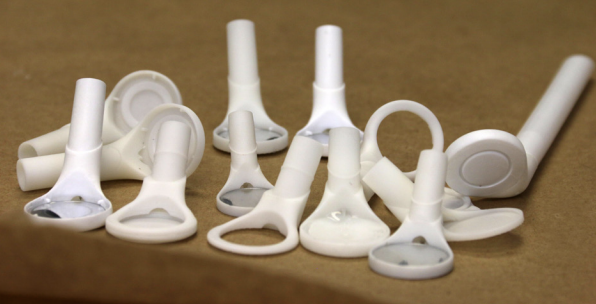
After testing a number of brands and technologies, P5 was sold on the EnvisionTEC Perfactory. The printer allows the production of everything from a tiny medical part to large packaging models – quickly, painlessly and accurately. Additionally, the range of resins available for the EnvisionTEC Perfactory provides a huge number of options. This includes hard and soft materials, flexible, tough and even temperature resistant materials.
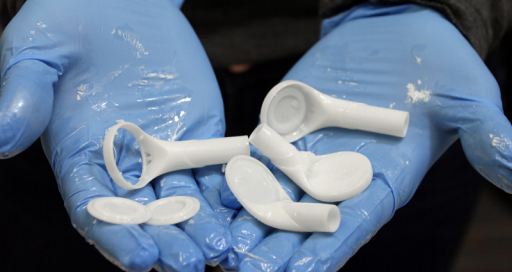
These processes are both time consuming and expensive, requiring specific skills and tooling to achieve. They also result in a vast amount of wasted material. Additive manufacturing is becoming a vital part of prototyping for many companies. Multiple iterations and design tweaks can be achieved quickly and without the need to reproduce or modify molds. Additionally, unlike milling techniques, there is no specialist tooling required. P5 has been using 3D printing for a number of years, recognizing that its implementation has not only removed many of the costs associated with the R&D process but also improved the speed at which concepts can be turned into real-world objects. Multiple iterations of a prototype can be printed simultaneously. Speeding up the decision-making process.
“3D printing is vitally important to the product design process. It helps us bring into the 3D dimensional realm some of the concepts that we have. The ease of use, the amount of detail we get and the vast materials selections available was something that was missing in most other manufacturers. The quicker we can start putting things into our hands, the quicker we can start developing the fit and feel that is so vital to any good product design part.” – Mr. Paul Carse – Owner, P5 Designers
“When we are in the heat of a project, especially in the very early stages where we are doing a lot of design development, we will use this machine for maybe 2-3 weeks straight with non-stop building. Reliability has never been an issue.” – Ms. Kelly Duncan – Industrial Designer, P5 Designers

Since the purchase of the EnvisionTEC Perfactory, the team at P5 have embraced its flexibility and speed. The accuracy of the machine has allowed them to produce prototypes to very high tolerances and accurately to their digital designs. Accurate prototypes that reflect the production items can be produced and handled by the customer very quickly. This allows clients to see and feel their vision and adjust designs to achieve the look and feel they desire. The dimensions of the build plate and Z height on the Perfactory allow for multiple iterations of a design to be printed at the same time, so options can be presented to the client. This capacity also allows for larger objects to be produced with equally fine detail. When adjustments are required, these can be quickly achieved with re-prints in a matter of minutes or hours.
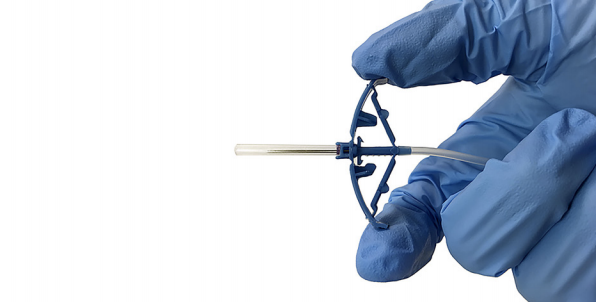
The patented technology employed by the printer results in exceptional surface quality with very little visible stepping. This increases the speed of prototype production further by reducing the finishing time required. The range of EnvisionTEC materials and the ability to painlessly switch these for different jobs makes the machine very flexible, allowing them to fulfill the needs of more customers. For example, the ability to print medical devices on one print, then switch to clear bottles on the next.
After using the Perfactory for hundreds, if not thousands of jobs it has proved reliable and provides consistent results time after time. The team at P5 can rely on the machine, knowing that even when leaving it overnight to complete prints, they will return to a completed job, and a printer ready to accept the next.
“We want to make our concept models as close to injection moulding as possible. So we’ll make sure that everything has a uniform 1-1.5mm wall thickness which a Perfactory has no problem doing. It makes really clean crisp parts, which is great.” – Ms. Kelly Duncan – Industrial Designer, P5 Designers
The large Z height on the Perfactory allows for the production of even large models. Additionally models can be printed horizontally or vertically to maximize yield per print. Even small medical devices can be produced to extremely high tolerances.
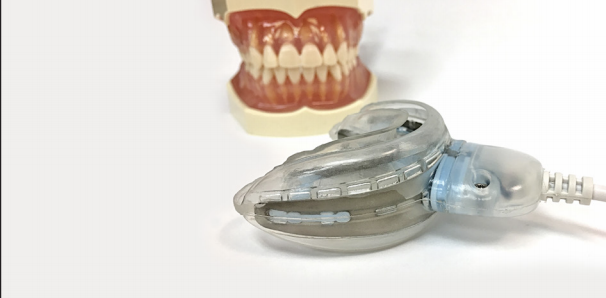
Since EnvisionTEC machines are STL agnostic the team at P5 are not locked to a single CAD provider. Moving is simple. Additionally, as all EnvisionTEC Perfactory machines are based on the same principles and are compatible with the same resins, expanding the printing capacity is easy. Machines can be added without the vast cost of retraining their team or implementing new software.
EnvisionTEC offers a full range of desktop, full-production and high-speed continuous 3D printers for the production of highly detailed prototypes for design verification and testing or for real mass production of custom products. Learn more here. Want to download the case study, you can go here.
The post Industrial Design and Development Company Chooses EnvisionTEC for the Production of Accurate Prototypes appeared first on 3DPrint.com | The Voice of 3D Printing / Additive Manufacturing.
Speed and Castability: What Factors Affect Final Casting Results?
Over the past few years, 3D printing has been transforming the jewelry industry. The introduction of 3D printers gives jewelers the capability to produce castable, high detailed parts in a fraction of time. But not all 3D printers are created equal, and casting results may vary widely, leaving some custom jewelers and manufacturers frustrated.
Additive manufacturing cuts production time dramatically when compared to traditional hand-carving methods and lately there has been a race for developing faster 3D printers for jewelers to produce rings in a matter of minutes and not hours. But does build speed really matter in 3D printing? Should you have to sacrifice quality to achieve it?
With a long standing history of 3D printing innovation, EnvisionTEC focuses on real solutions to real application problems. The company introduced its patented Continuous Digital Light Manufacturing (cDLM) technology so that jewelry professionals wouldn’t have to choose between speed and quality.

DLP technology, which was first developed and patented by EnvisionTEC, has been the gold standard for 3D printing jewelry. A standard DLP 3D printer builds parts in layers, one layer at a time. Each layer must be exposed to the light source and the time of exposure is defined by layer thickness and material reactivity. Once a layer has been exposed, and the specified layer is formed, a layer separation procedure is performed to peel the layer from the bottom of the material tray and replenish fresh resin to cure the next layer.
Over the years, EnvisionTEC has perfected a number of patented methods of minimizing the effects of this peeling separation, with highly castable options available to the jewelry industry that are widely used from custom designers to large manufacturers. But there are limits to the amount of wax that can be used with DLP 3D printing.
When using wax-based materials, the exposure times are typically three to four times that of regular plastic acrylic polymers. The higher the material castability (i.e. wax content), the slower the exposure time. A number of other 3D printer manufacturers claim that they can produce rings in minutes using a standard layer peeling process. However, their resins contain much more plastic than wax, resulting in less than optimal casts with significant surface roughness and porosity.
EnvisionTEC’s cDLM technology works by adding an air gap (similar to the air gap below the puck on an air hockey table surface) between the part being built and the bottom of the material tray. By building a floating layer, the separation forces are completely eliminated – so there is no peeling at all. With no separation forces, cDLM 3D printers are able to print resins with up to a 90% wax fill (Easy Cast 2.0), allowing for patterns that are as easy to cast as any traditional hand-carved or injection molded wax pattern.
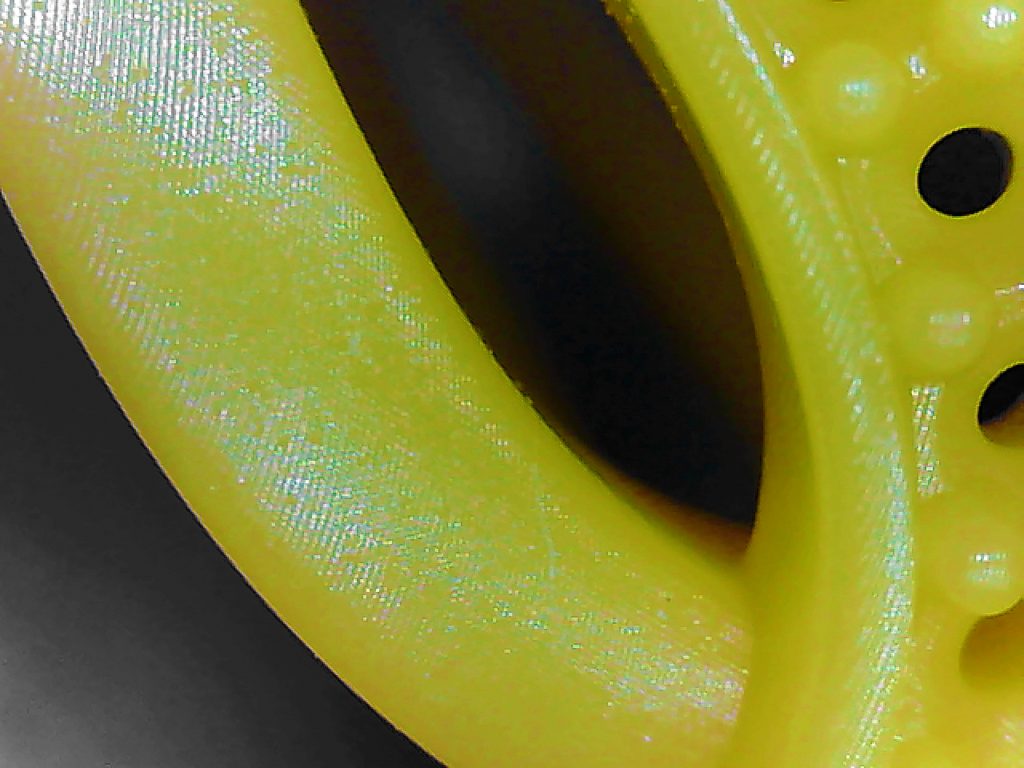
On top of all of this, the cDLM process is fast, allowing jewelers unprecedented manufacturing turnaround times. Traditionally, 3D printing castable materials would take hours to build. However with the cDLM technology, bridal and fashion rings can be designed, grown, and ready for investment casting the same day, which is a huge advantage for the jewelry market.
If you need a solution for 3D printing premium quality wax patterns for jewelry quickly that can also be easily casted, view EnvisionTEC’s cDLM technology. For more information visit: EnvisionTEC Castables.

IT’S SUPER-FAST — CONTINUOUS DIGITAL LIGHT MANUFACTURING
- Parts built as the platform moves continuously without separation, which leads to a drastic reduction in the building time as well as allowing for highly wax-filled resins to be used.
- A drastic reduction in separation, forces delivery of highly accurate parts, with detailed feature resolution.
- Better castability, as the wax based resin is cured twice as much during the build process, when compared to building using non continuous traditional DLP 3D printers. This delivers a porosity-free casting from EnvisionTEC’s ash free castable materials.
- And more
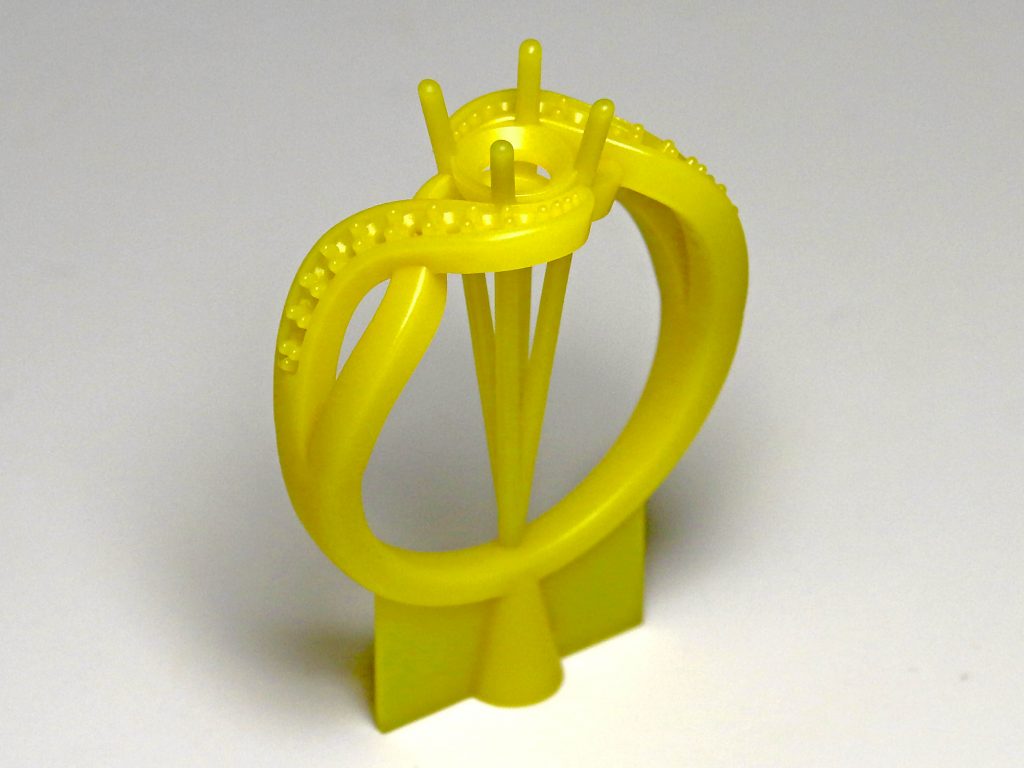
Rings printed in Easy Cast 2.0 at 15 µm on the EnvisionTEC Vida UHD cDLM.
Based in Florida, Isaac’s Fine Jewelry now produces rings, pendants and other jewelry in a fraction of the time of traditional methods utilizing cDLM technology.
3D Printed Jewelry | Precise, Fast & Highly Castable from EnvisionTEC on Vimeo.
EnvisionTEC’s combination of 3D printers and its range of exclusive materials provides Isaac with a real competitive edge. Click here to see a video of Isaac Cohen and others describing why they chose cDLM technology.

